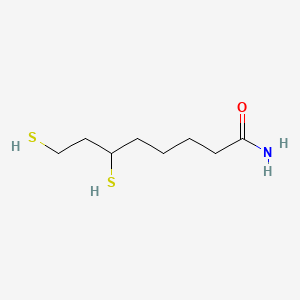| MeSH term | MeSH ID | Detail |
|---|---|---|
| Parkinsonian Disorders | D020734 | 20 associated lipids |
Dihydrolipoamide
Dihydrolipoamide is a lipid of Fatty Acyls (FA) class. Dihydrolipoamide is associated with abnormalities such as Wiskott-Aldrich Syndrome. The involved functions are known as Citric Acid Cycle, Electron Transport, NADH oxidation, Oxidation and Oxidants. Dihydrolipoamide often locates in Mitochondria, Mitochondrial matrix and Chloroplasts. The associated genes with Dihydrolipoamide are Mutant Proteins, Recombinant Proteins, mycothione reductase, Genes, Mitochondrial and alanylproline.
Cross Reference
Introduction
To understand associated biological information of Dihydrolipoamide, we collected biological information of abnormalities, associated pathways, cellular/molecular locations, biological functions, related genes/proteins, lipids and common seen animal/experimental models with organized paragraphs from literatures.
What diseases are associated with Dihydrolipoamide?
Dihydrolipoamide is suspected in and other diseases in descending order of the highest number of associated sentences.
Related references are mostly published in these journals:
| Disease | Cross reference | Weighted score | Related literature |
|---|
Possible diseases from mapped MeSH terms on references
We collected disease MeSH terms mapped to the references associated with Dihydrolipoamide
PubChem Associated disorders and diseases
What pathways are associated with Dihydrolipoamide
There are no associated biomedical information in the current reference collection.
PubChem Biomolecular Interactions and Pathways
Link to PubChem Biomolecular Interactions and PathwaysWhat cellular locations are associated with Dihydrolipoamide?
Visualization in cellular structure
Associated locations are in red color. Not associated locations are in black.
Related references are published most in these journals:
| Location | Cross reference | Weighted score | Related literatures |
|---|
What functions are associated with Dihydrolipoamide?
Related references are published most in these journals:
| Function | Cross reference | Weighted score | Related literatures |
|---|
What lipids are associated with Dihydrolipoamide?
There are no associated biomedical information in the current reference collection.
What genes are associated with Dihydrolipoamide?
Related references are published most in these journals:
| Gene | Cross reference | Weighted score | Related literatures |
|---|
What common seen animal models are associated with Dihydrolipoamide?
There are no associated biomedical information in the current reference collection.
NCBI Entrez Crosslinks
All references with Dihydrolipoamide
Download all related citations| Authors | Title | Published | Journal | PubMed Link |
|---|---|---|---|---|
| Crăiţoiu MM et al. | Clinical and histoenzymatic interrelations of the edentulous ridge's mucosa. | 2011 | Rom J Morphol Embryol | pmid:21424039 |
| Sengupta J et al. | Nitric oxide in blastocyst implantation in the rhesus monkey. | 2005 | Reproduction | pmid:16123239 |
| Johnson M et al. | Maternal enzyme masks the phenotype of mouse embryos lacking dihydrolipoamide dehydrogenase. | 2009 | Reprod. Biomed. Online | pmid:19573295 |
| Wu TF et al. | Proteomic investigation of the impact of oxygen on the protein profiles of hyaluronic acid-producing Streptococcus zooepidemicus. | 2009 | Proteomics | pmid:19688725 |
| Snoussi S et al. | Adaptation of Salmonella enterica Hadar under static magnetic field: effects on outer membrane protein pattern. | 2012 | Proteome Sci | pmid:22304719 |
| Nam MH et al. | Comparative proteomic analysis of early salt stress-responsive proteins in roots of SnRK2 transgenic rice. | 2012 | Proteome Sci | pmid:22462395 |
| Wang W et al. | Proteome analysis of a recombinant Bacillus megaterium strain during heterologous production of a glucosyltransferase. | 2005 | Proteome Sci | pmid:15927046 |
| Ajith VK and Prasad R | A novel protein that binds to dnrN-dnrO intergenic region of Streptomyces peucetius purified by DNA affinity capture has dihydrolipoamide dehydrogenase activity. | 2009 | Protein Expr. Purif. | pmid:19481152 |
| Self WT et al. | Synthesis and characterization of selenotrisulfide-derivatives of lipoic acid and lipoamide. | 2000 | Proc. Natl. Acad. Sci. U.S.A. | pmid:11050172 |
| Feeney MA et al. | Repurposing lipoic acid changes electron flow in two important metabolic pathways of Escherichia coli. | 2011 | Proc. Natl. Acad. Sci. U.S.A. | pmid:21521794 |
